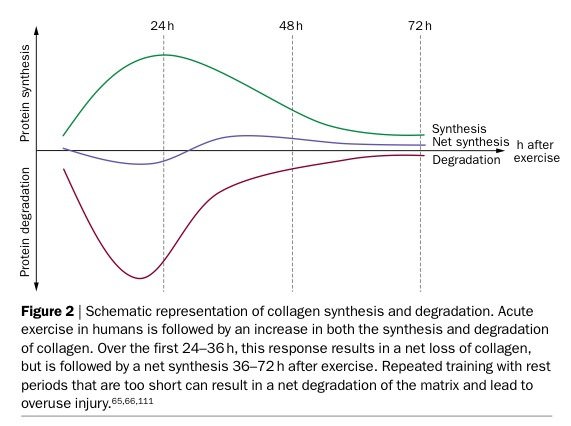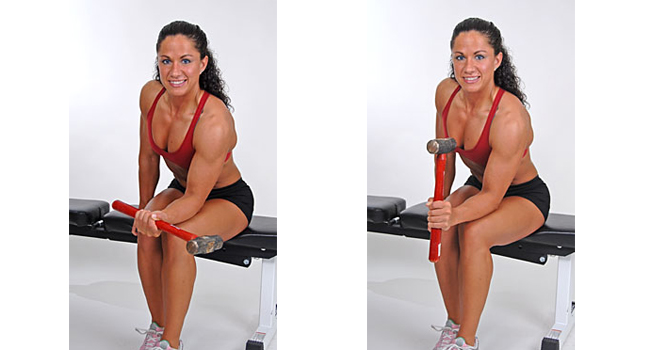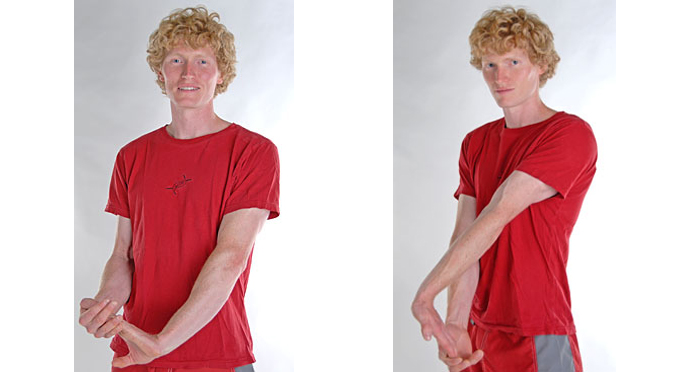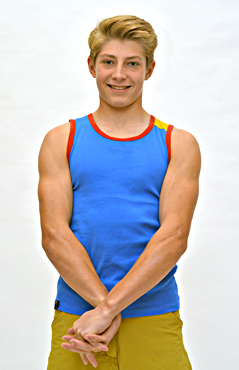Dealing with climbers Tendonitus/ Tendinosis/ climbers elbow/ golfers elbow
Over the years I have had many injuries which have prevented me from climbing, but by far the most long term, frustratingly hard to get rid of and most common is Tendinosis of the elbow. If you're here you've probably experienced it and are probably willing to do anything (except months of consistent physio) to get rid of it.
What follows is a distillation of my research and experience, my own personal opinions, and a bunch of links to the best sources I could find. Hopefully it helps- it helped me... The good news is that you can get rid of this and continue climbing. The not so good news is that there are no short cuts- you are gonna have to find the physio that works for you and keep doing it!
Also this is a fairly rapidly evolving area of research- look for recent articles as there has been alot of change in approach over the last 15 years. Things are still evolving and will hopefully become clearer in the future... This is my best effort at putting things together but there is a long way to go! Yes it is long winded, because there are so many contradictory ideas and therapies out there. I attempt to look at them all, and make some kinda sense out of Dr Google... Without some kinda context you are gonna get more lost then a snow flake in a snow storm, in Antarctica, on a cold day, in the middle of an ice age, on winter solstice...
Definitions
For years I have called the chronic (long term underlying) pain on the inside of my elbow, tendonitus. Well apparently it is really called or tendinosis, and is caused by the degeneration/ breakdown of collagen in the tendon, in turn probably caused by a continuous cycle of overloading with not enough rest in between. It is non inflammatory, and should probably not be treated with NSAID's such as ibuprofen. You will find it tends to get better and worse, and that it may feel better after and during climbing. This is probably what you have. Takes 3-6 months to fix.
Tendonitus is an acute/ immediate injury that you will have done to a tendon, that you will feel right away, and will continue to hurt, cause local inflammation, pain and warmth. Ibuprofen helps with this. Takes 4-6 weeks to fix.
Tendonopathy seems to be a catch all term for anything going wrong in your tendons, but tends to be used more in association with tendinosis.
In practice most people call anything wrong with your tendons, tendonitus, medical folk however like to be more specific. This is a great link explaining the differences.
Causes of golfers elbow/ climbing elbow/ Medial epicondylitis
By climbers elbow, I am talking about that dull aching pain that you may get on the inside of your elbow, just inside the bump on your elbow. If you press there, it can really hurt. It can get so bad that you can not lift a beer or twist the lid off a jar. It can really hurt, will get worse, and will mess up your climbing over many years.
There seems to have been a lot of rethinking about the causes and treatment of tendinosis in the last 20 years. Age is definitely against you, especially over 40. Kids are unlikely to have this. Consensus seems to be that the key is in loading and recovery cycles.
Simply put, it takes at least 36 hours for a tendon to get back/ heal to it's pre exercise level. If consistently over months or years you don't allow these 48 hour recovery periods between stressing it, your tendons will gradually degrade until you reach a critical point, where rather then rely on internal tendon processes to produce and integrate collagen and other stuff for repair, an external vascular process is activated, whereby extra vascular systems are recruited/ grown along with nerve material, to try and repair the tendon. This extra vascular and nerve system is associated with tendonopothy, and is suggested to account for the pain. Also gotta say, that nobody really seems quite sure what is going on here, but these are the current best guesses..
The pathogenesis of tendinopathy: balancing the response to loadings 2010.
Tendon injury and repair: A perspective on the basic mechanisms of tendon disease and future clinical therapy 2017.

Personally I first inflicted this upon myself by regular sets of pull ups on big slopey holds. Campus boards seem to eat elbows, as does any repetitive over training/ activity.
There is a lot of disagreement on what works and what doesn't. The emerging consensus is that the only thing that has been demonstrated to work in properly controlled studies, are specific eccentric exercise regimes. Other approaches may help with pain in the short term, but long-term are at best useless, perhaps even counterproductive. There is an excellent entertaining 2007 article here that you should read. I think that the dosages and timing in the article may be a little sub optimum, but he has been getting good results.
The cure
As well as the article above, you need to spend some time digesting this article. This is the best thing I found, and I think it is essential reading...
The best cure is prevention- take rest days and do not train at your max level 2 days in a row. Start incorporating eccentric exercises into your weekly training routine. Limit your level of max intensity climbing to as short a period as possible- under 2 hours would be best. For example have a good hour burn on your project in the morning, rest for 6 hours and try again in the afternoon, then rest the following day. Slogging away at it all day everyday is a recipe for injury and tendinosis.
As soon as you notice that you are beginning to have issues, do something about it- it won't get better on it's own. Pay attention to what exacerbates it. Most likely it is something that you are doing receptively in your training. It is probably something that compresses the tendon- for example the last bit of a pull up, or pulling all the way up and locking off on a sloper. For me it was pulling up fully on slopey holds. Back right off doing the movement that makes it worse. Definitely stop training it, but don't stop climbing all together. Bizarrely enough complete rest can also be very bad. When you rest completely the tendon is not stimulated to repair realign the collagen structure of a degenerated tendon. So you need to find a sweet spot, where you stimulate repair and realignment of collagen, but do not incur further damage. The answer seems to be well timed eccentric exercises. They are boring, tedious, and don't really feel like a work out, but if you do them consistently they will work.
When doing anything for tendinosis, you need to be very wary of not aggravating/ making it worse. Some pain is to be expected and worked through (up to 4/10 whatever the fuck that means...) but- and this is important- if the next few hours/ day it feels worse- i.e. if what you are doing is aggravating it- then you need to immediately adjust what you are doing- reducing weight, frequency, number of reps, changing angles of wrist etc- this fine tuning is why a good physio is really useful- if you can find one!
Pain Relief/ Isometric exercises- Phase 1
Isometric exercises involve resisting force without moving the joint. They are the latest thing in managing the pain for tendinosis and are the Phase 1/ first thing you wanna try. For climbers elbow, bend your arm at 90- 130 degrees, palm up. With your other hand provide an immovable force to push against, and push up with about 50% of your max effort for about 30 seconds. Taking 40 second breaks in between, do this 3 times. The angle of your wrist may be straight, or bent up- whatever gives you the most relief.
The idea of this is to provide pain relief, and it seems to work for an hour or so. Do this whenever you are feeling a lot of pain- maybe 3 or 4 times a day as needed. Some proscribe this as a cure in itself, but really I think it is about pain management to allow you to progress to the eccentric loading exercises.
Isometric exercise induces analgesia and reduces inhibition in patellar tendinopathy 2015
Eccentric loading- Phase 2
Eccentric loading is the exercise of a muscle group by slowly uncontracting it- e.g. lifting/ curling a dumbell is contracting/ concentric, slowly lowering/ uncurling/ releasing the muscle is eccentric Once you have a handle on the pain by avoiding anything that aggravates your condition, and have got your Isometric pain relief working- then you should start doing these as well.
Essentially, two basic exercises are prescribed- the Reverse wrist curl and the hammer thing. There are however many permutations of how and when you do them. To me it simplifies down to two approaches. You can do 10 minute, light sessions up to three times a day (once every 6 hours), for example 3 sets of 15 reverse curls with a 1kg weight. The idea is to stimulate the tendon without overloading or tiering it- you are basically stimulating it's repair mechanism, without degrading it. Kind of as indicated by this research: Minimizing Injury and Maximizing Return to Play: Lessons from Engineered Ligaments.
The other approach is too really work the tendon. One way is via Heavy Slow Resistance training (HSR)- e.g. 10-15 reps of reverse curl with something heavy enough to bring you within 2-3 reps of failure (3 sets), or something which is about 70%-80% the weight of the maximum you can do one of.
Another way is via lots of reps, (30-50), you should stop 2-3 reps before you would fail (3 sets). With this approach you only do this once every 48 hours (as indicated by the graph above). This approach has been shown to breakdown the extra vascular and nerve tissue associated with chronic tendinosis, which may help with the chronic pain (opinions differ). Increase weight over time and tweak the reps so that you are always within 2 or 3 reps of failure as you end the third set.
Everyone has there own ideas on the best approach- but you need to pick one, and stick with it. If it is not working, try the another approach. I am lazy, and like to bundle it in with my climbing/ training days- so I go heavy with the once every 48 hours/ 2-4 times a week, and make it 6 hours after a climbing/ training session...
The angles..
Basically you should do both the exercises with your arm bent at the angle which brings on the most pain, usually between 90 and 150 degrees. Good old Dr Julian has a good article on it here.
Reverse wrist curl:
Try doing high reps with a low weight. Start with the reverse wrist curl-
Place your wrist, palm up, over the arm of a sofa, or better, the edge of a desk, with enough clearance for your hand to lower and not touch anything. Take the dumbbell and tilt it so that your little finger is slightly higher than your thumb, and your wrist is fully flexed. With your arm and shoulder relaxed, lower the weight as far as you can. This should take about five seconds. Relax your grip and, with the other hand, lift the weight back into position. Do not use the hand you are exercising. We are interested in an eccentric load (aka negative contraction) only. This will stimulate the tendon to strengthen without putting too much duress on the muscle. How? The muscle is about 40-percent stronger when contracting eccentrically. Hence, it is not stimulated to strengthen to the same degree as the tendon. Because the tendon has a vastly smaller blood supply, gains in strength take longer. Note that your thumb is on the same side of the bar as your fingers.
Start with 3 sets of 30, then gradually work up to 3 sets of 50. It is essential that you do not do it to failure on the reps. So pick a weight that you can do 30 reps with without failure (prob around 2-4kg).
Alternatively 3 sets of 10-15 with something heavier 4-8kg so that you are within 2 reps of failure on the third set.
Hammer time:
Hold a hammer at the end of handle, arm bent between 90 and 150 degrees and slowly lower it from vertical to horizontal (5 secs). There is debate wether you help it back up or not... 3 sets of 30, work up to 50- stop before failure. You tube vid.
Alternatively 3 sets of 10-15 with something heavier/ lower down the handle, so that you are within 2 reps of failure on the third set.
Yes it is most tedious...

Frequency-
As per the graph above- no more then once every 48 hours, especially for HSR, and really probably a little less- think 2-4 times a week. If you go for a very light weight, with a low number of reps 10-15), then you may be able to do it 3 times a day, 5 days a week. But there is disagreement around this.. Personally I'm going for the less is more approach. If one does not work, try the other, likewise with HSR verses high reps.
Eccentric training as a new approach for rotator cuff tendinopathy: Review and perspectives 2014
Eccentric verses Concentric
The traditional idea is to focus on the eccentrics, using your other hand to help move the weight back to the starting position. More recently this has been questioned, with some evidence perhaps indicating that both are good- so for example you could slowly bring the hammer down, and then using the same arm, rapidly bring it back to the starting point. It seems with this style the eccentric movement is performed slowly, over 5 seconds, and the return/ concentric movement as quick as you can. I would start with the traditional eccentrics only, but as you build strength, perhaps try out the concentric movement as well. If it aggravates though, go back to pure eccentrics.
Equipment
Well there are two exercises, but a million ways to do them... I think the most effective for the curls is with dumb bells, but you can also use rubber bands or the flex bar- especially if you are travelling. As for the hammer- well lets face it, there are better options then a hammer- think big stick, think tapping a water bottle or rock to the top of the stick. Just make sure the grip is comfortable- use tape to bulk it out- make it harder depending on how close to the bottom of the stick you hold..
Other approaches
The below paper shows that only the first 10 minutes of tendon stimulation produces a molecular/ cellular response associated with tendon repair and growth. After 10 minutes, the molecular signals started to switch off. Intensity, frequency, max load etc seems to have little effect on the response. It takes around 6 hours before the tendons return to a state where further stimulation produces a molecular response to loading.
So perhaps very light low intensity stimulation for no more then 10 minutes, 3 times a day would be the optimal regime to promote tendon repair and growth.
The paper also found the use of collagen and whey supplements was beneficial, and recommends taking them 30-60 minutes before training. However the paper was testing this with artificial tendons in a dish, so wether eating the magic powder will allow it to show up around the tendon at the right time and will benefit it in the real world remains unclear.
Minimizing Injury and Maximizing Return to Play: Lessons from Engineered Ligaments
Supplements
Sure I have tried them, fuck me I have been desperate enough to try anything! Did they work? Ummm not that I noticed but they made me feel like I was doing something and may have helped... definitely not a deciding factor though. I have heard it said that you don't grind up then eat eyeballs and ears to improve your eyesight and hearing, so why would eating ground up tendons help your tendons... The problem is around how what you put in your mouth would somehow make it into your blood supply, and then make it to the site of the damaged tendon and sit there long enough to be useful. Even approaches involving injecting magic gunk directly next to the tendon have shown little if any difference. Approaches which surgically implant strips of slow release impregnated magic gunk near the tendon perhaps show some promise, but are not that convincing...
That said hope springs eternal and somebody always has some evidence that there may be benefits, but not enough to convince actual medical experts in the field, and the evidence tends to involve artificial tendons in petri dishes.
Tapping, bracing and other mechanical gizmos
Personally I reckon it is useless, and probably encourages you to injure yourself more. I am not alone in this thinking.
NSAID's / ibuprofen, Hot, Cold and Massage
Research seems to show that this is actually bad for tendinosis. Personally the dam things work like magic and makes it way easier to get out of bed in the morning. That said I am trying to ween myself off vitamin I, as I am pretty sure that in the long term they are doing more harm then good.
Icing it has been shown to be probably useless, and perhaps not so good... Heat may help and makes it feel better.
Massage won't cure it, but when you are doing the physio, it will help with the pain and discomfort of sore tortured flesh. I am a personal big fan of it.
Stretching
For me stretching seems to help a lot. My stretching regime, for what is worth...
However there is research that suggests that deep stretching can actually make tendinosis worse. So I would suggest trying what works for you and closely monitoring it.
The classic miracle stretch that many people swear by is a yoga pose where you lay face down with you arms palm down under you, and do alternate leg raises. Personally it did nothing for me, but it is a good workout!
I like to do the following- (images shamelessly stolen from Eric Horsts site). I personally like to hold each of these for around 60 seconds, once a day.

Finger and wrist flexors stretch

Extensor stretch
Dodgy Dan's magic formula...
Well if you have made it this far, then you have a good appreciation of just how speculative and in its infancy the science behind treating tendinosis is. At least maybe you understand why so much information is contradictory, and nobody out there agrees on a recipe. That is why you have physios, who will if they are any good make constant adjustments to what you are doing until something works. Also nobody really wants to stick their neck out and publish their magic formula as there are bound to be a deluge of critics and haters. Me I am just an interested amateur with nothing to lose, so here goes...
- Figure out exactly what you are doing that brings this on, and avoid/ change it as much as possible.
- Use Isometrics for pain relief just before exercises and whenever else you feel you need it.
- Do the exercises on your climbing/ training days, around 6 hours after you are done.
- Do 3 sets of 10-15 reverse wrist curls with something heavy enough to be within 2 curls of failure on your last set (stop before failure).
- Do 3 sets of 10-15 of hammer time with something heavy enough to be within 2 reps of failure on your last set (stop before failure).
- If these exercises aggravate it- change them by reducing reps/ weight or try the higher reps regime
- Do the exercises once every 48 hours. If you take an extra day off sometimes (i.e. 3-4 times a week), that's probably a good thing. You are probably going to need to keep doing this for several months/ forever...
- For masochists, choke down some vitamine c infused collagen gunk 30-60 min before exercising, once you have finished the 3kg bulk bargain container of vomit paste, you will either wanna regurgitate your lunch at the sight of it, or be a convert forever and spread it on your toast.
- Stretch, keep climbing and do other exercises such as pushups, swimming on your days off.
- Self massage and heat is good, having someone else do it for you is better, as are margaritas, spliffs, sunsets and crips... Good luck!
Other links
Eric Horst is these days an institution in his own right. He has written many books on climbing training and associated injuries. His website is a gold mine of information. If I would be a critical, I would say that he has been doing this so long, that he tends to contradict himself at times, and has a lot of legacy content that may be out of date. This is a good thing, as he is really proactive on looking at the latest research, you just need to make sure you are reading his latest stuff. For years he used to take the piss out of the supplement industry, but more recently has become an ardent convert to nutrition, and now touts his own extensive range of supplements. He does make a pretty compelling case for the magic gunk..
Also have a look at:
- Tendinopathy Rehabilitation- modern approach and almost prescriptive
- The excellent Dr Julian- He actually publishes his Rehab formula!
- Straight forward prescriptive high rep, low weight, twice a day from the good old NHS.
- Eric Horst on tendinosis- I particularly like his stretches